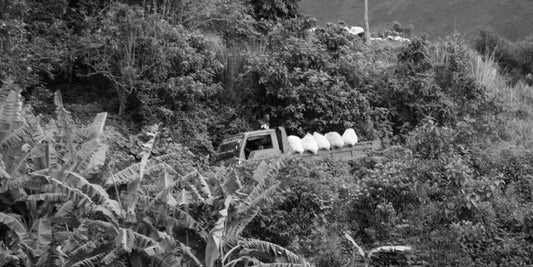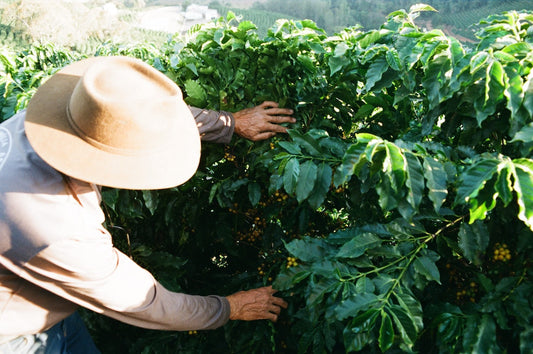
Washed, Honey & Natural – The Holy Trinity of Processing
Washed, honey and natural. What the hell are we on about?
No, we aren’t just writing random words next to each other in the hope that it looks kind of cool and edgy. I mean yeah, they do look cool and edgy but that’s not the point.
Those words are actually names for different coffee processing methods. There are so many variables that can affect the flavour in your morning brew, but the way the coffee has been processed – after it’s harvested – is one of the most influential factors. Understanding the differences will help you make better judgements when buying coffee.
More than ever we’re now seeing wacky new processing methods, but the three listed above are the OGs of coffee processing. So whilst everyone else is up to their eyeballs in anaerobic-thermal shock-washed-naturals (that’s not a thing, by the way), we’re celebrating the basics. After all, they are the three fundamental processing methods that all others are built on.
As always with coffee there are several different names for each processing method, which is super unhelpful and confusing. The sense of one upmanship is strong in the roasting game so roasters are always looking for ways to differentiate their offering from the next guy. Finding a fancy-pants way of describing the processing method is a good way to do this. However, this makes it an absolute minefield for the consumer and is why so many people feel like they need a science degree to understand the information on a pack of coffee.
In this post we’ll aim to detangle the chaos and confusion, and break things down into something more approachable.
This is why we like wine. Not just because it tastes great and gets us hammered, but because there is a more standardised and universal terminology used in wine. Coffee has yet to adopt this (for various reasons), but that’s what we’re here for!
Right, let’s jump in. There are some variations on each method which we’ll discuss and explain in each point, and we’ll do our best to describe the effects of each processing method on flavour.
WASHED // WET-PROCESSED // FULLY WASHED
Let’s start with the most complicated process. We know you can take it. Washed coffee undergoes the most involved process of all three methods, but is seen as the easiest way to create consistent quality in coffee.
Cherries are picked, then submerged in water as an initial quality check. Cherries that float are removed as it can mean they are defective or under-ripe. Once this initial check has taken place, ripe cherries are ready to be “depulped” or “pulped”. They both mean the same thing which is that the seeds/beans are squeezed from the cherry using a depulping machine. Sometimes the cherries are stored for a period of time before any floating or pulping takes place. During this time the cherries will begin to ferment and take on a fruitier flavour. This extended fermentation is sometimes referred to as “extended fermentation” (believe it or not), or if it’s done in air tight containers, is called Anaerobic fermentation.
Once pulped, the seeds/beans at this point are still covered in a layer of sticky mucilage and are sometimes left to ferment in tanks overnight, or for a period of time. This is when we see all that washing start to begin. Each producer will do things a little differently, but essentially the tanks the coffee is in will be filled with fresh water and agitated. More floaters or defective beans can be removed at this point. The amount of time the beans are in contact with water will depend on the producer, but what the water does is activate an enzyme in the mucilage which will help break itself down when the beans dry.
Next comes drying. This is sometimes done on concrete patios, or often on raised mesh beds. Either way they will be spread out evenly and turned frequently. The aim is for the sun to work its magic, and since we’ve removed the flesh of the cherry and the mucilage, the beans will dry relatively quickly and without too much additional fermentation. Drying can take up to a couple of weeks. Some producers use mechanical dryers, sometimes called parabolic dryers, which is a really fancy way of saying “a raised bed that changes position to allow for even drying”. Some producers actually have artificial heat sources and use drying silos, although this is pretty rare and is usually reserved for small, special lots.
The coffee is then bagged up still in a thin, hard layer called parchment, ready for export. Storing coffee in parchment helps the shelf life of the beans. The parchment is removed just before export in a process called hulling.
Washed coffee is highly prized for it’s clean and crisp flavour. Because the beans have only undergone a small amount of fermentation the fruit notes tend to be much greener and crisper with florals and citrus fruit often dominating the cup. Chocolate notes can be found in all three processing methods, but we find washed coffee tends to have a “cleaner” chocolate flavour.
HONEY // SEMI-WASHED // PULPED-NATURAL
This process has only really gained in popularity in recent years as producers have experimented more with processing methods. Honey process is a hybrid that sits between the washed and natural process. To make things a little bit more confusing, there are literally hundreds, if not thousands of variations of the honey process. In fact, it’s wrong to think of honey processing as a defined, fixed thing, but more of a set of potential processes.
Honey process starts the same as any process, except only ripe cherries are picked and given an initial sort for any defects. As with the washed process they are sometimes stored for a short period of time, but generally depulped as soon as possible after picking. The main difference here is that once they have been depulped, they are then laid directly in the sun to dry, either on a patio, or on raised beds. The beans will be covered in their sticky mucilage, so the drying time will be longer than with washed coffee. This encourages a bit more fermentation which can give honey processed coffee a bit more of a fruity or boozy flavour.
Why “honey”? Well, once the beans start to dry the mucilage turns to a gloopy, sticky substance that makes the beans look like they’re covered in honey. If you’ve ever seen the description “white honey”, or “black honey”, these just refer to the colour of the mucilage as they dry. The variable being the thickness of the bed of beans during drying. Black honey will usually be dried in piles and hence will dry slower than yellow honey which will be spread in thin layers. The slower the drying (and the darker the mucilage) the more fermentation you can expect and more fruity/boozy notes there will be.
Wanna hear something crazy? Honey processed coffee can be washed. Yes, that’s right. Surely that’s just washed coffee, right? Well, no. If the beans are introduced to water for a short period of time they will still retain most of their mucilage and can still be considered a “honey” process.
Drying can take up to 2-3 weeks, coffee beans need to reach the correct moisture percentage prior to being packed for shipment, this is usually around 11% moisture. Again, the beans are hulled to remove the parchment and dry mucilage before export.
Honey processed coffee usually has the brightness of washed coffee but can adopt sweeter, fruitier or more boozy notes then washed coffee. Sometimes even a bit more complexity. We tend to find honey processed coffees a bit of a mish mash, and tend not to get too excited by them, although we have tasted some exceptional examples over the years.
NATURAL // DRY PROCESS // UNWASHED
This process is the oldest of them all, and the original processing method. It’s a real paradox. Some of the most expensive coffees (and the most exciting to drink) are naturals, but so are the cheapest, lowest grade coffees. This is because the cost of production is less, with the absence of water/equipment etc. but the chance of failure is much higher.
As with the other two processes the cherries are picked, but only super ripe ones. For the natural process to be successful under ripe cherries must be sorted out (or just not picked at all) before the process can begin.
Once picked they’re chucked in the sun to dry, and that’s it. Done!
Well, not quite. This is where it can all go wrong. Unlike the two other methods, there is much more material to dry. Not only are you trying to dry the seeds of the cherry, you also have all the flesh to contend with too. So, if the weather is against you, you could find that your crop is taking too long to dry, or worse yet, it rains during drying. This will obviously cause more fermentation, and if there’s too much, the beans will develop phenols, or can go mouldy, and spoil completely. That’s when it’s time to offload your crop to Nescafe. 😉
Get it right though and you could be sitting on something really special. When naturals are on point you can expect a sweetness and complexity that you can’t find in washed coffee. There tends to be a fruitier note, often jammy, sugary notes and a lower acidity than washed coffee. You can usually tell a natural from a mile away. They have a distinctive flavour.
Correct drying usually takes 2-4 weeks during which the cherries are turned regularly. They can be dried on patios or raised beds, and once the correct moisture content is reached the beans are hulled to remove the dried skin and parchment. They are then stored ready for shipment.
So, all in all the world of coffee processing isn’t actually all that complicated in the end. Honey is the exception where anything goes, but next time you’re buying coffee try and see if you can distinguish the character of the processing method.




